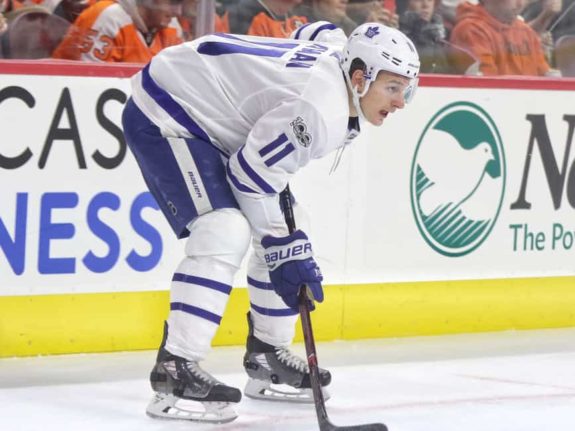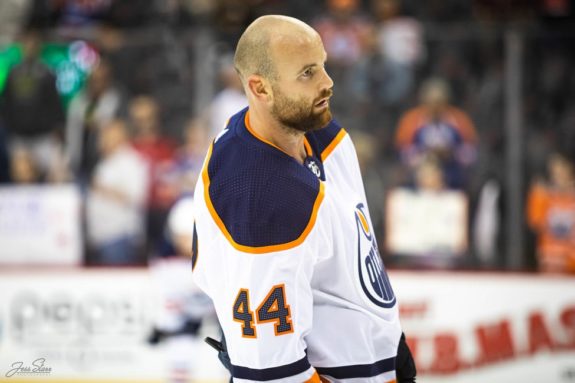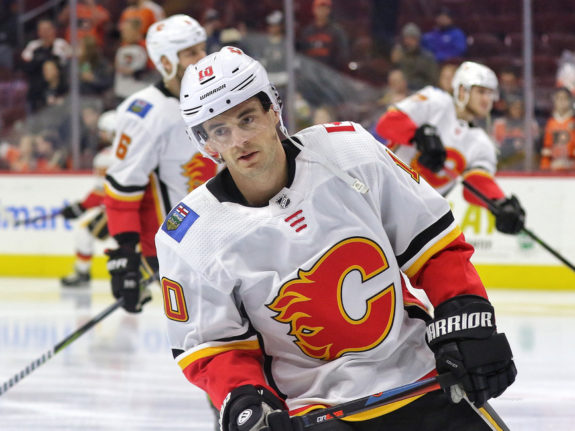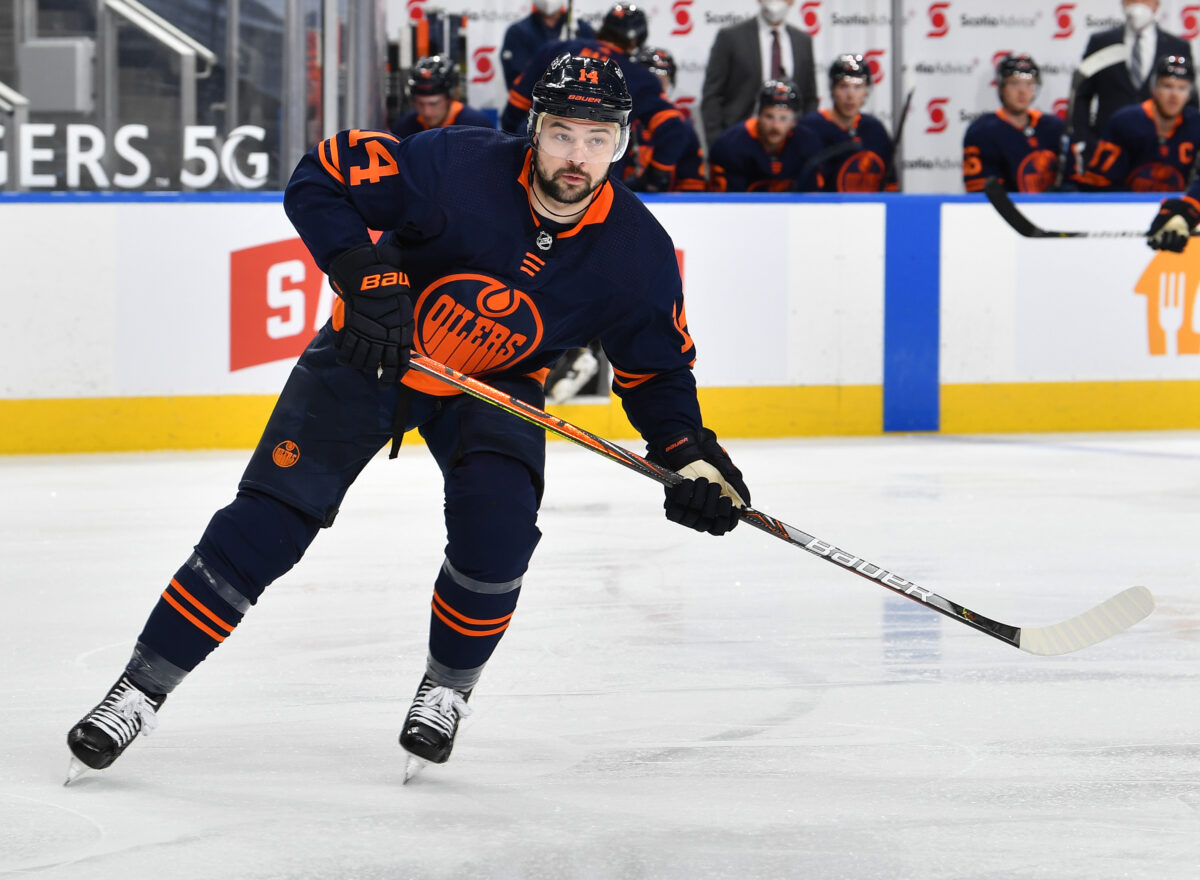The Edmonton Oilers made several offseason moves to bring in many new faces in the hopes of adding depth and balancing their attack. General manager Ken Holland is well aware that his franchise center needed help on his left wing and was an area that needed improvement. He also knew he needed to change the culture of his forward group and has tinkered with the bottom-six of his lineup as well. With training camp just around the corner, the battle for positioning will begin, and head coach Dave Tippett will need to start deciphering which players have the best chemistry and where each player slots into the team’s lineup to make the team most effective come puck drop.
*Health is assumed when these lineup projections are configured.*
Oilers First Line
Zach Hyman – Connor McDavid – Jesse Puljujarvi
Part of Holland’s significant moves this offseason came when they signed former Toronto Maple Leafs forward Zach Hyman to a massive seven-year deal. With Ryan Nugent-Hopkins having fallen out of form alongside McDavid last season and playing mainly with the second line, the top line left-wing spot is an obvious hole that needs to be filled.

Hyman brings tenaciousness with relentless puck pursuit and forechecking ability. In theory, Hyman should recover pucks and move them to his more skilled linemates to develop plays. He already knows how to play with highly skilled forwards like Auston Matthews and Mitch Marner from his time in Toronto and keep up with both their speed and skill, which should make for an easy transition to McDavid’s flank.
As for McDavid, expect the same dominance that we are accustomed to seeing during his tenure. He played almost all of the 2020-21 campaign with a blossoming Puljujarvi, who showed he could be a solid contributor at the highest level. The two of them developed great chemistry last season and saw it grow as the season went on.
The addition of Hyman should free up Puljujarvi to take on more of an offensive role in generating more scoring chances and shots rather than focusing on forechecking and puck retrieval. Hyman has already skated with McDavid and other members of the team consistently in the offseason, and this line can be a tough matchup for opposing defenses while also being reliable in their own end of the rink.
Oilers Second Line
Ryan Nugent-Hopkins – Leon Draisaitl – Zack Kassian
One of my bold takes about the Oilers lineup projections heading into the season is having Kassian on the team’s second line right-wing. The spot that Kailer Yamamoto occupied for most if not all of last season will be up for grabs in training camp and ultimately won by Kassian. Yamamoto did not do anything to help his case to remain in this role, only posting 21 points in 52 games last season. Considering that Yamamoto has not skated much with the team in the offseason before training camps begin, the 22-year-old forward could find himself a few steps behind once he does resume team activities.

Kassian has previously seen time on the team’s top line before Puljujarvi’s arrival, but it doesn’t look like he will return to that previous role. However, he could be a great compliment on the second line that has an abundance of skill between Hopkins and Draisaitl. Having a player who can be a physical presence and create turnovers and space for his higher-skilled teammates could be a better complementary piece compared to Yamamoto.
Yamamoto doesn’t often provide Kassian’s ability to go hard to the net and be a nuisance to opposing defensemen and goaltenders, and the playstyle could play a more significant role in the final lineup decision rather than which of the two is the better player.
Leaving Nugent-Hopkins on the second line gives Draisaitl a reliable playmaker and setup man, allowing Draisaitl to focus more on getting free and putting pucks on the net. Nugent-Hopkins also makes life easier on Draisaitl defensively because of Hopkins’s strong defensive game and history of playing the center position. There is room for improvement for this tandem to be even better, considering Nugent-Hopkins had a less than compelling year by his standards with only 35 points in 52 games played which is far and away from what he is capable of producing.
Oilers Third Line
Warren Foegele – Ryan McLeod – Kailer Yamamoto
With Yamamoto signing a very team-friendly one-year extension, he finds himself in a spot to prove to the team he is worth more heading into his next deal. It would be beneficial for the team to slot him onto the third-line that has plenty of offensive potential in the hopes of getting him better matchups against the opposing team’s defensemen. The idea of moving Yamamoto to the third line is to help him be more of a catalyst rather than a role player like he has been in the past while in the top-six forward group.
Foegele, acquired from the Carolina Hurricanes in the Ethan Bear trade, is a speedy winger that can give the team versatility, depth scoring, and strong defensive-zone play. He will have a significant role on the teams’ penalty kill this season and could even play himself into a higher role in the lineup. Obvious question marks are surrounding the consistency this line would provide, considering his 200 games of NHL experience is the highest of the three players on the line. Still, the upside with this combination remains very intriguing.
The biggest surprise on this line is the role of 21-year-old centerman Ryan McLeod. He is clearly someone Tippett sees potential in, considering he played in all four of the team’s playoff games against the Winnipeg Jets last season despite having only 10 games of NHL experience up to that point.

Last season, he operated at a point per game clip with the Bakersfield Condors before being recalled from the American Hockey League (AHL). McLeod will still need to prove himself in training camp to the coaching staff that he is ready for a full-time NHL role and will likely be involved in a position battle with Kyle Turris. While Turris is looking to bounce back from the worst NHL season of his career, the third line center spot heading into camp is McLeod’s to lose.
Oilers Fourth Line
Kyle Turris – Derek Ryan – Josh Archibald
The offseason addition of Derek Ryan, who signed a two-year, $2,500,000 deal, shows the teams need to add strong defensive centerman depth to the roster. He will likely be a staple on the team’s fourth line this season and, despite his age, should be able to chip in 10+ goals and 25+ points at minimum. He is a good penalty killer who is vital in the faceoff circle and will be depended on to win many crucial defensive zone draws.

Combine the stability of Ryan with the crashing and banging of Archibald, and you already have the basis of a high-energy checking line. Archibald will be relied upon mostly to bring energy and hits to the lineup, which will be significant considering the team moved on from Adam Larsson and Juhjar Khaira, who were regular contributors in the hits department last season.
Related: 3 Oilers Who Could Surprise This Season
The last piece of this line will also likely be up for grabs in training camp between Kyle Turris and Devin Shore, in which Turris will ultimately come out ahead. For the time being, this spot appears to be Turris’ job to lose as he comes in with a much longer track record of being a consistent and reliable asset with scoring upside compared to Shore. Turris had the task of being the team’s third-line center last season, which ultimately did not come to fruition. So, having him in a more sheltered fourth-line role on the left wing should help relieve some of the pressure and allow him to contribute at a much higher level than he did last season.
Oilers Forward Depth
Colton Sceviour – Devin Shore – Seth Griffith
Shore is the most likely to earn a starting spot out of these three forwards, mainly because he landed himself a two-year deal with the team. There is familiarity with the coaching staff, and his ability to play all three forwards positions makes him easy to insert into the lineup. He can also play a solid two-way game and contribute to the penalty kill. If players like McLeod and Turris struggle early on, Shore is primed for a role in the bottom six.

Seth Griffith could get pushed out of making the roster with the addition of 500 game veteran Colton Sceviour. The Oilers signed Sceviour a professional tryout agreement to bolster their forward depth and add some toughness and low-end offensive upside to the roster. Griffith has had very strong AHL seasons in the past but has never been able to carry it to the NHL level. With only 79 games of experience, it is more likely Sceviour could get used more often than Griffith and win a roster spot in training camp.
Tippet Faced With Big Decisions
Heading into training camp, there is a lot of competition amongst players to either make the roster or for specific roles on the team. Holland has done a lot to change the culture of the team and address needs that may have led to their early exit in last year’s brief playoff stint. With a significant number of new faces brought into the organization over the offseason, Tippett is tasked with finding the line combinations that have high chemistry and fit the style and identity the team wants to play with this season.